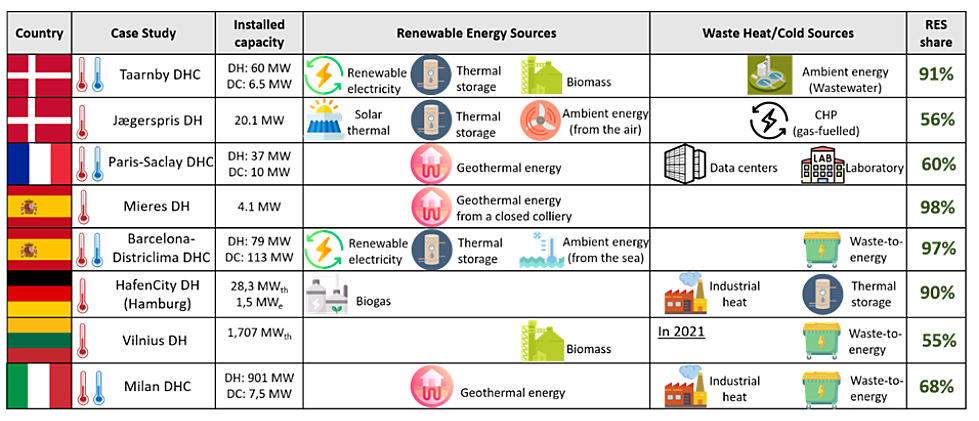Design and operation of district heating and cooling systems supplied by renewable energy sources
A report published by the European Commission analyses 8 efficient district heating and cooling systems in different Member States.
8 case studies of district heating and cooling systems (DHC) are analysed in this report published by the European Commission. [1] The study investigates the design and operation of these DHC systems powered mainly by renewable energy sources and (excess) waste heat and cold sources.
It has been conducted in Denmark, France, Spain, Germany, Lithuania and Italy.
DHC systems have an important role in the European Union’s energy transition strategy: it is one of the main infrastructures allowing decarbonisation through smart sector integration, while heating and cooling of buildings and industries account for half of the EU’s energy consumption, 75% of which is still generated from fossil fuels.
The 8 case studies cover a wide range of contexts, technologies, energy sources and management modes, as shown in the table below:

4 of the 8 systems concern district heating and cooling systems. The other case studies only mention district heating.
1. Taarnby, in Denmark.
In this city, the district heating systems has been installed in the beginning of the 1980’s. It provides 60% of the local heating market. The remaining 40% are provided by natural gas. In 2013, with the developments of large cooling consumers such as hotels or offices, district cooling began to develop. It is produced by large heat pumps. The main advantages are:
- A lower prize, enabling to benefit from economies of scale,
- Simple, flexible and turnkey solution,
- The possibility to integrate a chilled water storage tank and more efficient heat pumps
- The possibility to value synergies with other urban infrastructure
- The reduction of noise, vibrations and used space for cooling equipment.
The DHC system entered operation in 2020 and it has very innovative features such as:
- The value of combined heating and cooling and in particular in combination with the ground-source cooling
- The valued synergies with the wastewater treatment plant (WWTP)
- The thermal storage systems allow to dissociate demand and production, and to optimise the latter automatically depending on electricity prices.
- The integration within Greater Copenhagen’s DHC system, where the heat from Taarnby’s heat pumps can be optimised in combination with other heat production units.
2. Paris-Saclay, in France
25 buildings benefit from efficient and low-carbon heating and cooling. It is composed of several interconnected networks:
- A geothermal network connecting two drillings and transporting water from the Albien aquifer, the geothermal resource, to a centralised installation.
- A mid-temperature network (loop) running from the centralised installation to supply semi-centralised substations where the heat-pumps are located. This network aims at valorising very low-temperature energies.
- Several distribution networks of heat and cold water supplying decentralised substations from the semi-centralised substations.
3. Barcelona, in Spain
The DHC system is 97% supplied by waste-to-energy, renewable electricity and ambient energy from the Mediterranean Sea, with back-up supply being provided by gas boilers. The cooling system uses 2 absorption machines, 1 cold water storage tank of 5000m3, 4 electric chillers and an ambient energy refrigeration system with 3 exchangers of sea water/cooling water, and 1 sea water collection station of 5000m3/h.
4. Milan, in Italy
The district cooling is provided in Milan North. It supplies cooling to a University, a theatre and some private customers. The DC network represents 7 km length of double pipe and 6 GWh/y, generated by a 7.5 electric chiller and cooling towers.
The study aims at identifying the key success factors enabling the integration of those sources, and drivers and conditions for their replicability in other cities and communities. 10 key success factors have been identified and suggest 5 working areas to foster decarbonisation through DHC:
- accelerating the integration of renewable energy sources and waste energy sources in DHC through a comprehensive and coherent set of policies and support schemes,
- building a local and participative governance: cooperation and value-sharing,
- applying the energy-efficiency first principle across sectors, to move towards more integrated energy systems,
- making the right technology choices to progressively integrate low-carbon energy sources and district cooling,
- creating a robust business case for modern and evolutive DHC system.
For further information, please consult the study mentioned in the sources below.
Source:
